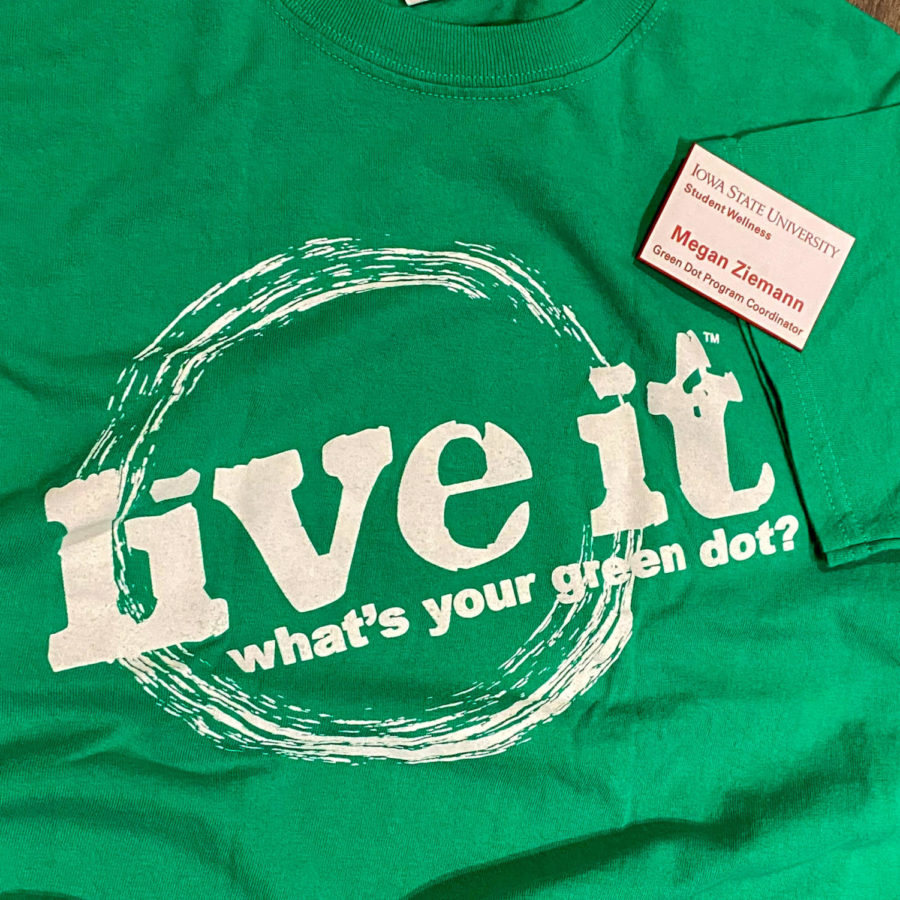Ziemann: What’s your green dot?
August 20, 2020
Believe it or not, I had a life before I became a columnist. I worked at orientation, I got a minor in French and I lived in not one but two forms of campus housing.
I have three whole years of non-Daily campus experiences, and one of them is working with Student Health and Wellness as a Green Dot program coordinator. I’ve been with Green Dot since July of last year, and I am one part of a twelve-person team of peer wellness educators and program coordinators that run Green Dot here at Iowa State.
My job focuses on outreach, so I manage the organization’s social media (primarily Facebook, Twitter and Instagram) and connect with campus leaders to get students signed up for events.
Green Dot and I arrived on campus at the same time — the fall of 2017. The organization is an offshoot of Student Health and Wellness and calls Friley Hall home. In the past, Green Dot has hosted daylong bystander trainings and 50-minute Green Dot overviews that offer people the tools they need to end power-based personal violence in the Iowa State community.
If I’ve done that job well over the past year, almost all of you should know a little about Green Dot. The program is an international bystander education system that works in high schools, college campuses and workplaces to end power-based personal violence.
Power-based personal violence is a big phrase, but Green Dot uses it for a reason.
Power-based personal violence has no gender.
Power-based personal violence has no sexuality.
Power-based personal violence simply means one individual hurts another by taking advantage of a power imbalance.
In our lingo, the act of hurting another person through a power imbalance is called a red dot. Red dots can be incidents of stalking, domestic violence or sexual assault. Red dots have happened in the past, are happening now and at the current rate, will happen in the future.
But we have the power to stop that. A green dot (sound familiar?) is any choice, behavior, word or attitude that promotes safety for everyone and communicates utter intolerance for power-based personal violence in your community.
A green dot can be directly engaging with people in the red dot situation to stop it from happening, contacting an authority or power-based personal violence resource for someone who may be experiencing a red dot or simply projecting to the world you are committed to ending power-based personal violence.
Writing this is a green dot. My pins on my backpack are green dots. My work uniform is a green dot.
Your green dot doesn’t have to be big. There’s a quote I use at every outreach meeting — “Not everyone has to do everything, but everyone has to do something.”
When we all take a part of the burden, it doesn’t feel as heavy.
Now is statistically the best time to become green dot positive, because this time of year is referred to by violence prevention experts as the “red zone.” Defined as the first six weeks of the academic year, the red zone sees a significant spike in sexual assault on college campuses. There are a number of reasons for this: a new class of students moves to a town some of them have never been to before, they are bombarded with the stressors of college and many students have just lost their group of high school friends.
Whatever the reason, more people get hurt at this time of year. And that’s not OK.
It’s important to remember while the red zone eventually ends, campus power-based personal violence does not. Now is a fantastic time to learn green dot strategies, but it is imperative we continue those strategies into the rest of the academic year.
That’s where Iowa State Green Dot comes in. Like everything else, our programming is changing this semester. Unfortunately, we will not be holding bystander trainings. Instead, all programming will be virtual and will include overviews, a healthy relationships booster as well as a new Green Dot refresher. The refresher is designed for people who have attended a bystander training in the past but still want to continue learning. The healthy relationships booster examines the traits and nuances of healthy relationships through a Green Dot lens.
The overviews are designed for student organizations and other student groups. The Green Dot refresher and the healthy relationships booster accommodate individual students as well as groups.
If you are interested in getting yourself or your group educated, fill out a request form through Student Health and Wellness.
Change happens together. We see a difference because we make a difference. And you bet the Iowa State Daily team will be receiving an email from me about updating their training.
I can’t wait to wave at you through the screen.

















